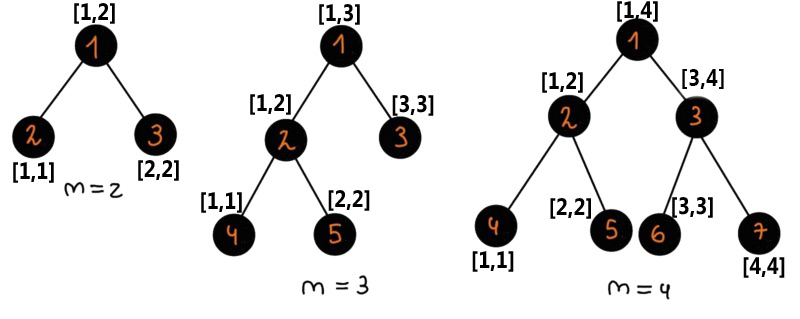| Codeforces Round 915 (Div. 2) |
|---|
| Finished |
In this sad world full of imperfections, ugly segment trees exist.
A segment tree is a tree where each node represents a segment and has its number. A segment tree for an array of $$$n$$$ elements can be built in a recursive manner. Let's say function $$$\operatorname{build}(v,l,r)$$$ builds the segment tree rooted in the node with number $$$v$$$ and it corresponds to the segment $$$[l,r]$$$.
Now let's define $$$\operatorname{build}(v,l,r)$$$:
- If $$$l=r$$$, this node $$$v$$$ is a leaf so we stop adding more edges
- Else, we add the edges $$$(v, 2v)$$$ and $$$(v, 2v+1)$$$. Let $$$m=\lfloor \frac{l+r}{2} \rfloor$$$. Then we call $$$\operatorname{build}(2v,l,m)$$$ and $$$\operatorname{build}(2v+1,m+1,r)$$$.
So, the whole tree is built by calling $$$\operatorname{build}(1,1,n)$$$.
Now Ibti will construct a segment tree for an array with $$$n$$$ elements. He wants to find the sum of $$$\operatorname{lca}^\dagger(S)$$$, where $$$S$$$ is a non-empty subset of leaves. Notice that there are exactly $$$2^n - 1$$$ possible subsets. Since this sum can be very large, output it modulo $$$998\,244\,353$$$.
$$$^\dagger\operatorname{lca}(S)$$$ is the number of the least common ancestor for the nodes that are in $$$S$$$.
Each test consists of multiple test cases. The first line contains a single integer $$$t$$$ ($$$1 \le t \le 10^3$$$) — the number of test cases. The description of the test cases follows.
The first line of each test case contains a single integer $$$n$$$ ($$$2 \le n \le 10^{18}$$$) — the length of the array for which the segment tree is built.
For each test case, output a single integer — the required sum modulo $$$998\,244\,353$$$.
5234553278
6 17 36 69 593324855

In the first test case:
Let's look at all subsets of leaves.
- $$$\operatorname{lca}(\{2\})=2$$$;
- $$$\operatorname{lca}(\{3\})=3$$$;
- $$$\operatorname{lca}(\{2,3\})=1$$$.
Thus, the answer is $$$2+3+1=6$$$.
In the second test case:
Let's look at all subsets of leaves.
- $$$\operatorname{lca}(\{4\})=4$$$;
- $$$\operatorname{lca}(\{5\})=5$$$;
- $$$\operatorname{lca}(\{3\})=3$$$;
- $$$\operatorname{lca}(\{4,5\})=2$$$;
- $$$\operatorname{lca}(\{4,3\})=1$$$;
- $$$\operatorname{lca}(\{5,3\})=1$$$;
- $$$\operatorname{lca}(\{4,5,3\})=1$$$;
Thus, the answer is $$$4+5+3+2+1+1+1=17$$$.
| Name |
|---|




